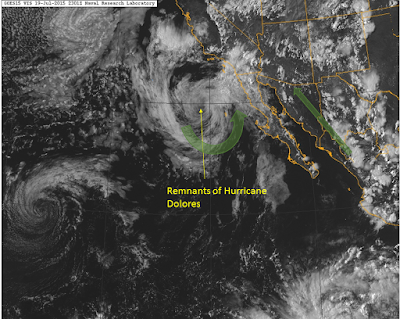It was an interesting and exciting start to the week in the northern Rockies, northern Plains, and southern Manitoba. Snow, a long-lived tornado-producing storm, and hurricane force wind gusts were the result of an unusually strong low pressure system that developed over the northern Rockies on Monday and then rapidly intensified as it moved northeast into Manitoba. This system was fed by very warm, humid air to the southeast of the low and cold, dry air to the northwest, and was associated with a strong closed upper level low.
 |
| 500 millibar map Tuesday, July 28, at 7:00 a.m. showing closed low over northern Montana and southern Manitoba. |
 |
| Surface map for July 27 at 10:00 p.m. CDT |
On Monday there was snow in Wyoming, Montana, and Idaho. There were several inches of snow above 8,000 feet elevation, including snow at ski areas in Jackson Hole, WY and in Glacier National Park in northwestern Montana. Flurries were even reported in Missoula. Temperatures on Sunday in western Montana and northwestern Wyoming were in the mid 80s, but on Monday daytime high temperatures were only in the low to mid 50s.
 |
| Surface temperatures at 5:00 p.m. MDT on July 27. |
Strong thunderstorms developed northeast of the low pressure system late Monday, and one particularly strong storm developed over southwestern Manitoba during the early evening. This thunderstorm put down a tornado southwest of Melita, Manitoba around 8:30 p.m. CDT.
 |
| Radar image showing strong thunderstorm over southwestern Manitoba at 9:41 p.m. July 27. A hook echo is evident on the south end of the storm. |
 |
| Radar base velocity image for 9:56 p.m. CDT on July 27. The white oval marks where rotation is indicated. Green colors are movement toward the radar. Red colors are movement away from the radar. |
The tornado moved north-northeast over the next two and a half to three hours. At 10:55 p.m. CDT the storm was observed near Virden, and it's possible it lasted for a time after that but was not observed because of darkness.
 |
| Map showing approximate locations and times of the observed tornado. |
It's possible that the thunderstorm produced multiple tornadoes rather than one very long-track tornado, but there was no doubt this was a monster storm. At one time the storm was estimated to be one kilometer (.62 mile) wide. Fortunately the tornado missed populated areas and there were no known serious injuries. The tornado did damage farm buildings, trees, power lines, and actually ripped pieces of asphalt from a highway. Meteorologists from Environment Canada have been investigating the damage and preliminarily assigned it a high EF-2 rating on the Enhanced Fujita scale. The damage survey has been hampered by the fact that the tornado did not hit many structures and spent much of its time over open fields. Of course, for the residents of the area that's a good thing.
On Tuesday the strong low was moving through Manitoba, and the intensifying low generated strong winds across southern Manitoba and North Dakota. Winds gusted to 70 mph and more at several locations in North Dakota, with the highest wind gusts of 76 mph reported at Garrison in central North Dakota and Alkabo in the northwestern corner of the state. Wind gusts in excess of 55 mph were common in western and central parts of the state. In eastern North Dakota winds gusted from 40 to 50 mph with the highest gust 59 at Devil's Lake and McHenry.
 |
| Surface map for Tuesday, July 28, 4:00 p.m CDT |
Large-scale strong low pressure systems such as this are rare during the summer. This type of system typically occurs in the late fall to early spring, and often is associated with snow and blizzard conditions in the winter.


















